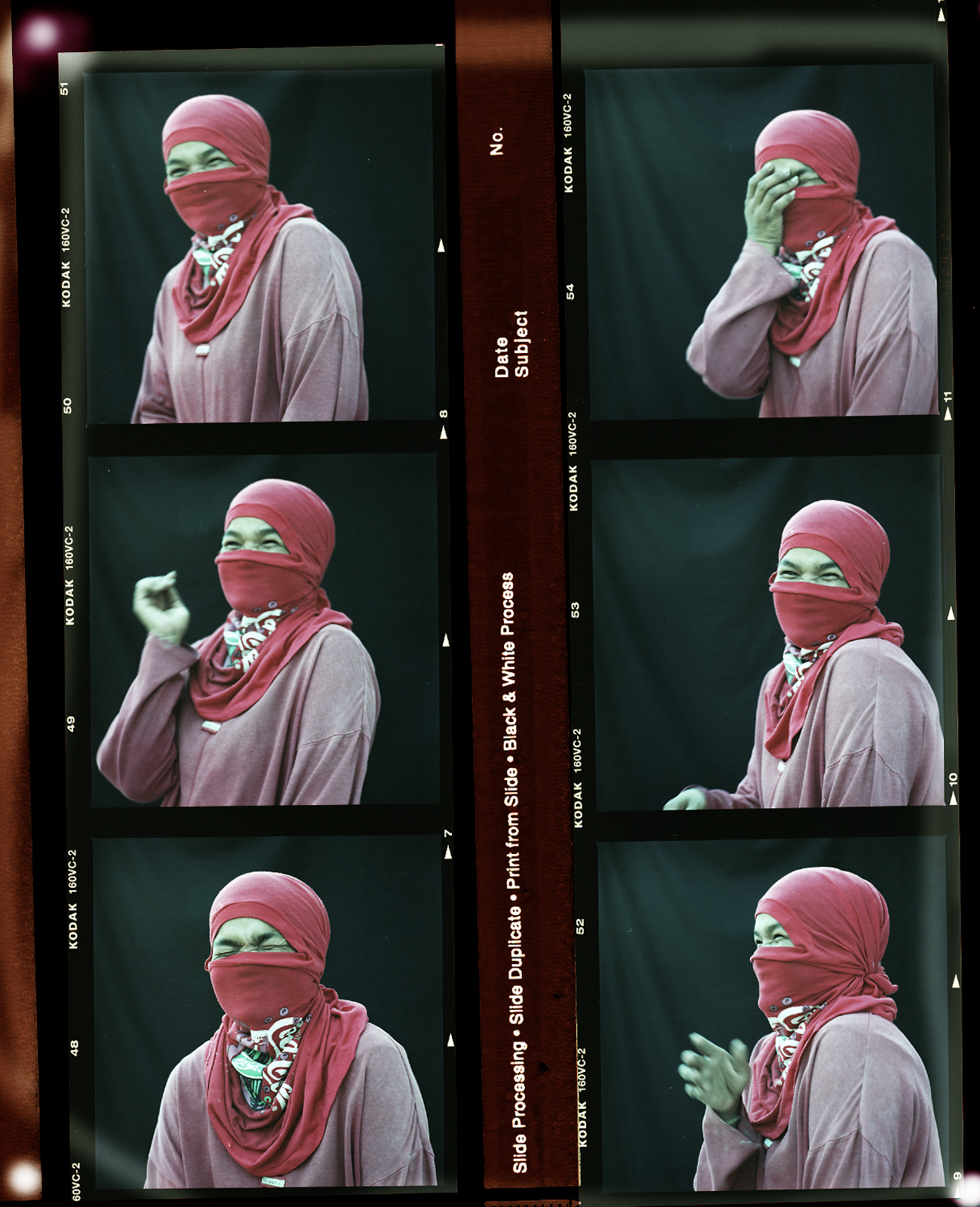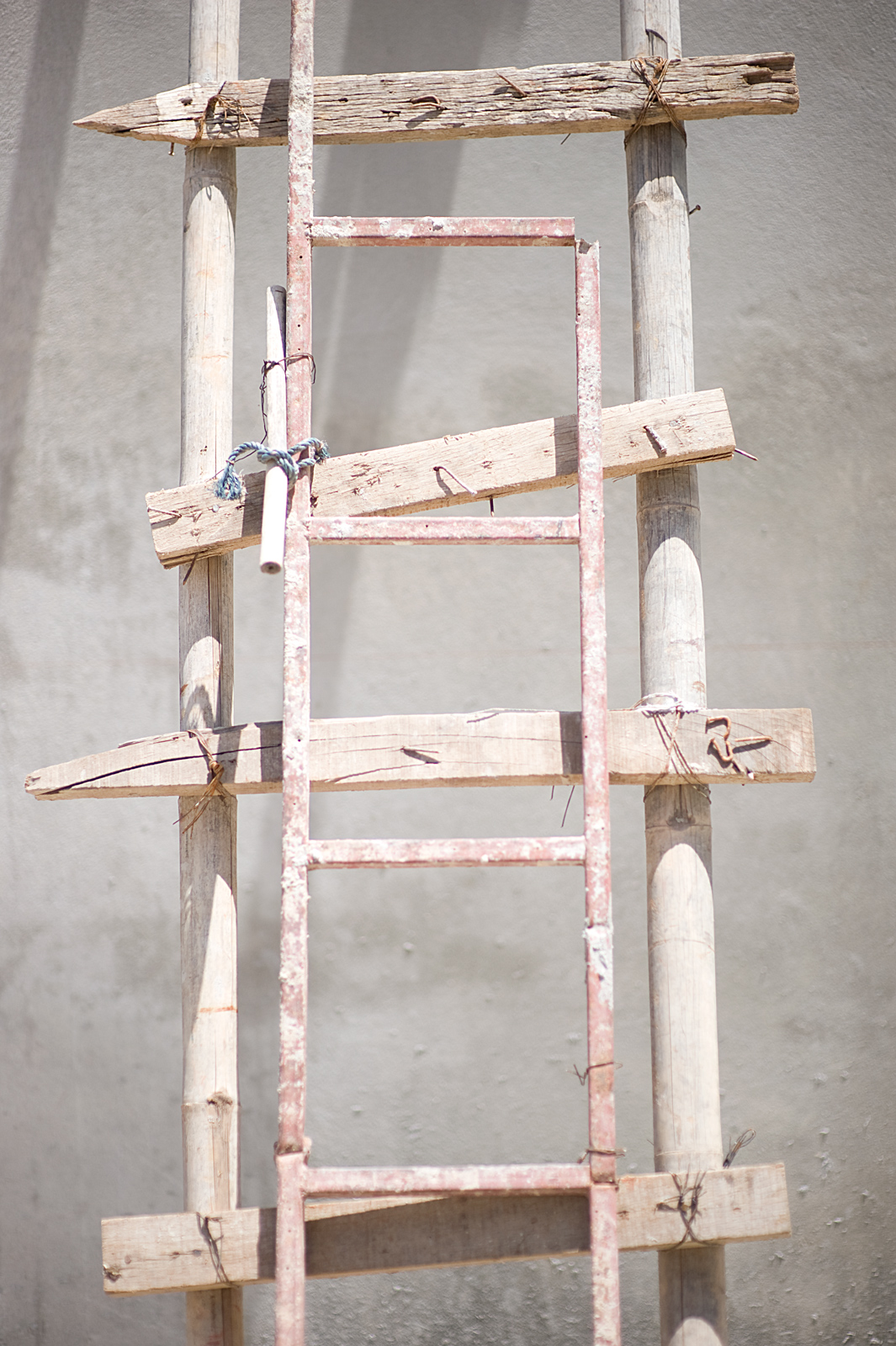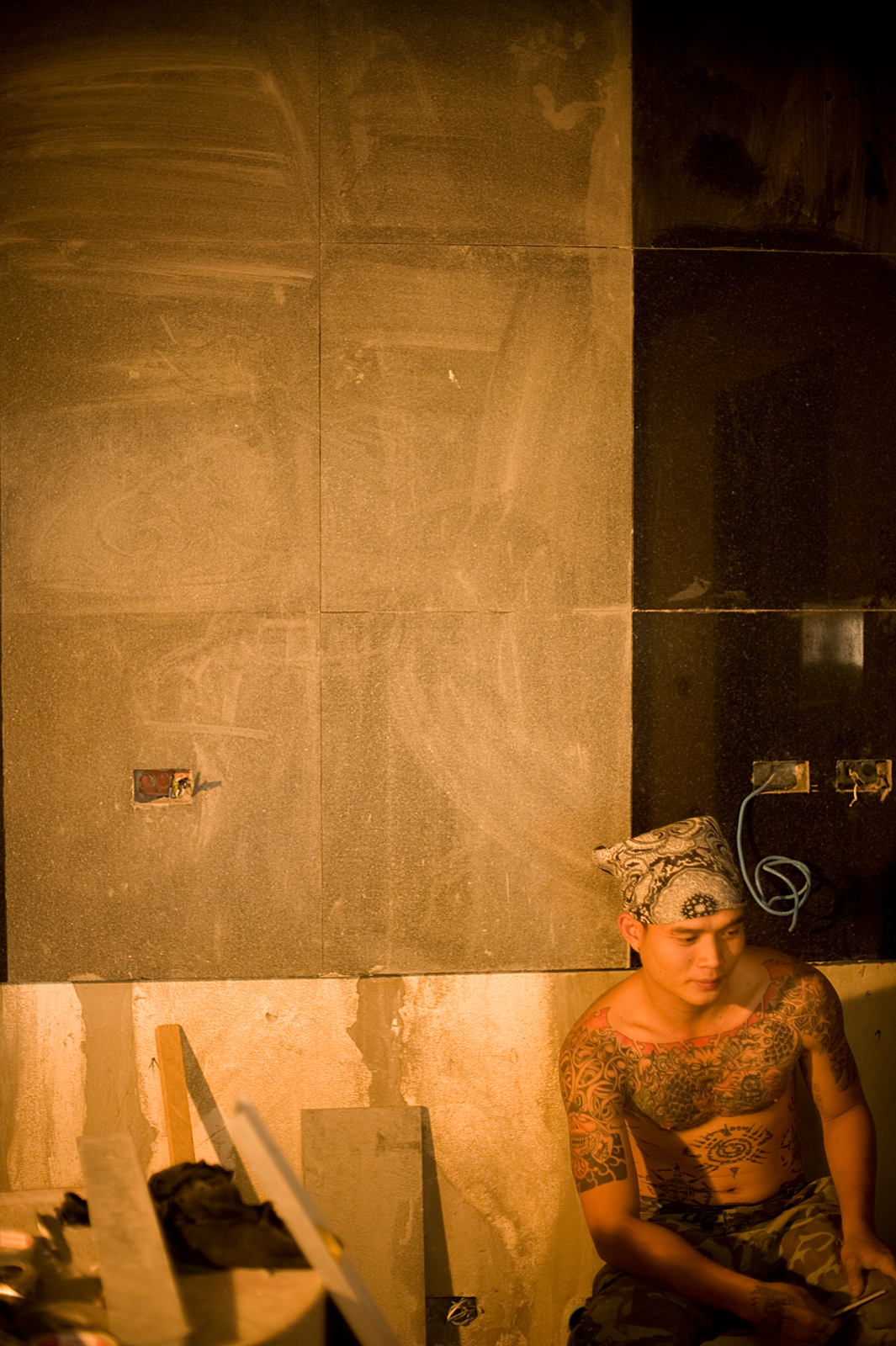ASIAN WORKER COVERED A.W.C.
A.W.C.
Ralf Tooten’s series “A.W.C.” reveals an unseen side of “workplace culture”: haute couture meets streetwear, and anyone who assumes that professional wear and fashion are two different worlds will quickly see both in a new light. In these fantastic, sometimes truly futuristic guises and disguises, workers elevate themselves above their work and become individuals – all of them effaced and yet personal at the same time.
This workplace wear, produced from recycled items, protects the workers’- some of them illegal – identity, shields them from dust, toxic gases and glaring sunlight, and is therefore absolutely practical as well. But at the same time it discloses a sense of aesthetics that one expects on the runways of Gaultier or Steve McQueen, but not in the inventions of workers, as an outbreak out of the uniformity of overalls and functional work clothing.
The special accomplishment of this stunning series, entitled “A.W.C. (Asian Worker Covered,” lies in its recognition of their creative will; bringing them together and highlighting their uniqueness and dignity. A different look at workers.
Roger Willemsen
German author, essayist and TV presenter
Bangkok, April 2008
A.W.C.
Not content with pointing his camera lenses towards the cultural and earthly civilisations that bind the world together in his critically-acclaimed series, Eyes of Wisdom, (which has since been serialised in a hardcover compendium), German photographer Ralf Tooten has now fervently captured the intimate compositions of ordinary street workers in his new portraiture series. Possessing a highly individual and imaginative conception, (and that’s not just about postulating technique or style), Toosten has the eyes similar to an enthusiastic archivist, and being a competent photographer, was smitten by the mysticism and intimate everyday details of life through portraits of street workers of all ages and occupations.
All colour prints, there is symbolic as well as humanist photography on view with each subject averaging around 3-4 shots. Looking through the images closely, one obvious commonality is that all faces are being covered – masked, for lack of a better word – with various clothing fabrics. Ski masks, t-shirts, sun hats & glasses etc, there is a direct approach pertaining to the subject being photographed. As fanciful yet unassuming in how the people create ways to hid part of their heads and faces, the absolute beauty lies simply on the clear accessibility unleashed by the photographer’s click.
Tooten has deliberately zoomed in what we have been exposed to but not noticed in the daily fashions of these workers, especially in today’s urban conditions where we are bound by endless construction, reinforcing the reality in its purest state. In other words, these images leave one with a deep unique impression about the trusting relationship with the inhabitants and their environment or the very existence of nature itself.
Josef Ng / Curator
Tang Contemporary Art Gallery
Bangkok
- June 2007
A.W.C.
By Peter Bialobrzeski
Designers have always been fascinated by the analysis of formal structures. The propmaker and draftsman Karl Blossfeldt, used photography made use of photography to study the ornamental structure of plants. Photo historians then made use of Blossfeldt by placing him among the representatives of the New Objectivity, including August Sander and Albert Renger Patzsch. They collected fragments of the world; in this sense they might be considered legitimate descendants of the last universal genius, Alexander von Humboldt. Since Bernd and Hilla Becher became icons of the contemporary art scene in the`Seventies, what seems like the documentary equivalent of butterfly-collecting has thereupon been proclaimed „artistic,“ almost as if doing so needed no explanation.
„AWC“ plays with this approach without trying to venture out onto the thin ice of claiming to be art. In his new work, Ralf Tooten, a German photographer who has been living in Bangkok for more than 4 years, provides a fascinating look at the „worker bees“ of globalization. “AWC” stands for “Asian Workers Covered,” for a species that we mostly see only from afar on Asia’s gigantic, anarchic-Babylonian construction sites. Tooten’s photos seem like electron-microscopically enhanced images of strange insects, almost as if he had used a macrolens. Tooten, who gained international acclaim at the turn of the millenium with his work, „Eyes of Wisdom,“ admits candidly that his fascination was primarily aesthetic: „No Paris fashion designer could have invented a more exciting combination of old T-shirts, ski-masks and hats.“ His statement explains why his protagonists are not presented formally facing the camera, but in both profile as well as frontally. In some way, these figures seem to be “cool;” thanks to Tooten’s play with strategies familiar to us from avant-garde fashion photography. If we take a closer look, our first, superficial attraction dissolves into a chorus of questions: Why are the masks so frayed? Why are the eyes behind the slits so empty? Why are the workers so covered up in the first place?
Workers on Asian mega-construction sites do not only protect themselves from the sun, their guises assure them anonymity. These day laborers, often illegal immigrants from any and all of the earth’s rogue nations, work without protective helmets or safety boots, making a very “fashionable” impression at first glance. Tooten does not portray them as victims, his aesthetic play respects and honors this way of protecting one’s body and identity from harm and disclosure that is so alien to us. What has long since degenerated into cynical gesture, to tired subculture citation at the hands of the Lagerfelds and Westwoods, Joops and McCartneys of this world, finds a powerful resurrection in the series „Asian Workers Covered.“ „Vernacular Fashion“ cannot be presented more authentically or beautifully. It is from this contradiction that Tooten’s photo series derives its power. The almost naïve, playful handling of the disguises and the deeply serious admonition behind it; that anyone in our world – colonized by capital as it is – who ever checks into a cheap 4-star hotel in Bangkok, acquires an investment share in real-estate, or even buys an apartment must face the fact that the costumes of these cool young men and women have nothing to do with role-playing. They have no choice. They earn only a few dollars a day, but all of our respect. Ralf Tooten makes this plain – with great elegance.
The geometry of FACES…..Asian Workers Covered.
By Josef Ng
For Ralf Tooten, whose photographs fit comfortably within the high-finish realm of portraiture photography, the German photographer never chooses an easy way to documenting a subject matter that is common to the point of cliché.
Fascinated by the aesthetics of visual encounters and the personal radiance of human beings, Tootel has travelled around the world, pointing his camera lenses towards the cultural and earthly civilisations that bind the world together for his critically-acclaimed series, Eyes of Wisdoms, (which has since been serialised in a hardcover compendium), which took him more than 3 years to complete. From arranged sessions with renowned spiritual leaders to shooting chance encounters on the road, usually activities and people in rural locales, Tooten achieved considerable intensity on sepia tone productions, injecting the element of humanity and motion through his mastery of subtle tonal gradations.
The geometry of faces, peoples, languages and ethnic customs live on in memory. Tooten provides no narrative in this series. The result is luminous.
With his new series, A.W.C., an acronym for Asian Workers Covered, Tooten has fervently captured the intimate compositions of anonymous labourers. This series will also be part of the artist’s contribution to the Goethe-Institute’s Southeast Asia regional project, CITY SCAPES, soon to be launched later this year. Possessing a direct approach as its conceptual underpinning, Tooten has the eyes similar to an enthusiastic archivist, and being a competent photographer, was smitten by the mysticism and everyday details of life through photos of these usually street workers of all ages and occupations.
Based largely in Bangkok, Thailand in the last 5 years, he spent a lot of time in the country’s construction sites cruising for his subjects. Decidedly, he zoomed in on those workers, specifically with faces covered in various clothing fabrics such as ski masks, t-shirts, sun hats & glasses etc.
Underlying this adventuresome project is a desire, a constant search for the unconventional yet the chosen workers must possess unbridled openness to be photographed in every angle and inch of their faces, and for some, including their upper bodies. Time wasn’t a luxury on Tooten’s side either as he has to make sure he is not intruding on their working circumstances particularly as some of them are seemingly illegal migrants and any public exposures could put these workers into an imminent disadvantage.
Once the workers are handpicked, they were persuaded to sit for several sessions, separately, while Tooten photographed them with some of the subjects stare directly at the camera, and others, either from the back or their faces gaze off into space. Both documentary and devotional by intent, though Tooten’s esthetic repertory is repetitive and strictly limited, his ruthless simplification achieved a miraculous range of effects.
We are used to workers portrayed as marginalized subjects even in an increasingly pluralistic society that the world seems to be function under but Tooten has given them an unexpected moment of individualized appearance. Viewed close up, these portraits, that are by turns comical and discomforting, become satisfying personal; the constructed of the self is thus on display.
There is symbolic as well as humanist photography on view with each worker averaging around 3-4 shots. There is a direct approach pertaining to the subject being photographed. As fanciful yet unassuming in how the people create ways to hid part of their heads and faces, so by reading between their eyes, these photos position the viewer between the clarity of what is seen and the elusive nature of what can be understood. As renowned German author/essayist Roger Willemsen expressed, “The accomplishment of this stunning series lies in its recognition of the workers’ creative will; bringing them together and highlighting their uniqueness and dignity.”
In this series, executed in large square-format prints, the covered cloth, with coordinated colours and patterns chosen by the workers, also tend to render the force of their personalities, giving their concealed identity great charm and for Tooten, these models of his are more often elegant than ordinary, and the photographs are so appealing precisely because they are at once engaging, tender and straightforward.
Tooten has deliberately zoomed in what we have been exposed to but not noticed in the daily fashions of these workers, especially in today’s urban conditions where we are bound by endless construction works, reinforcing the reality in its purest state. In other words, these images leave one with a deep unique impression about the trusting relationship with the inhabitants and their environment or the very existence of nature itself.
In the midst of an international debate over border migration and intense social security, these portraits might be read as solely a commentary on our society’s cautiousness towards who is the unfamiliar and who is part of us. Yet, the mischievous tone and freshness of approach in this series is a testament to the photographer’s lightness of touch that these do not weigh the pictures down.
In this exhibition, as if all the photographs are bound together as one entity, the presentation between the exhibited prints and the gallery space also play an important role. Factors related to site-specificity will determine and enhance how the viewers might engage with the subject matter, perhaps re-activating various levels of interpretation of the portraits in a temporal frame.
All in all, Tooten both entertains and leaves a strong enough impression to help us see the source material in a new light.
M E D I A R E L E A S E
Tang Contemporary Art presents
A.W.C.
A contemporary photography exhibition by Ralf Tooten
Curator: Josef Ng
Exhibition Duration: August 21 – September 13 – 2008
Exhibition @ Tang Contemporary Art – Bangkok
B-28 (Basement), Silom Galleria
919/1 Silom 19 Road, Bangkok 10500 Thailand
Mon – Sat 11am – 7pm
(Closed on Sunday and Public Holidays)
NOTE: This exhibition is in partnership and co-sponsored by the German Embassy, Goethe Institute Thailand, Ulrike Crespo Foundation and Helvetia Wealth / Switzerland.
OPENING RECEPTION: Tang Contemporary Art cordially invites you to the opening reception on Thursday, 14 August, 6.30 pm onwards. To be presided by Theodor Proffe, Head Press and Cultural Affairs, Germany Embassy.
EXHIBITION BACKGROUND
Not content with pointing his camera lenses towards the cultural and earthly civilizations that bind the world together in his critically-acclaimed series, Eyes of Wisdom, (which has since been serialised in a hardcover compendium), German photographer Ralf Tooten has now fervently captured the intimate compositions of ordinary street workers in his new portraiture series, A.W.C. which will also be part of the artist’s contribution to the Goethe-Institut Southeast Asia regional project, CITY SCAPES. Possessing a direct approach as its conceptual underpinning, Tooten has the eyes similar to an enthusiastic archivist, and being a competent photographer, was smitten by the mysticism and intimate everyday details of life through portraits of street workers of all ages and occupations.
In the exhibition, simply titled after the series, there is symbolic as well as humanist photography on view with each subject averaging around 3-4 shots. Looking through the images closely, one obvious commonality is that all faces are being covered – masked, for lack of a better word – with various clothing fabrics. Ski masks, t-shirts, sun hats & glasses etc, there is a direct approach pertaining to the subject being photographed. As fanciful yet unassuming in how the people create ways to hid part of their heads and faces, the absolute beauty lies simply on the clear accessibility unleashed by the photographer’s click. As renowned German author/essayist Roger Willemsen expressed, “The accomplishment of this stunning series lies in its recognition of the workers’ creative will; bringing them together and highlighting their uniqueness and dignity.”
Tooten has deliberately zoomed in what we have been exposed to but not noticed in the daily fashions of these workers, especially in today’s urban conditions where we are bound by endless construction, reinforcing the reality in its purest state. In other words, these images leave one with a deep unique impression about the trusting relationship with the inhabitants and their environment or the very existence of nature itself.
In this exhibition, as if all the photographs are bound together as one entity, the presentation between the exhibited prints and the gallery space also play an important role. Factors related to site-specificity will determine and enhance how the viewers might engage with the subject matter, perhaps re-activating various levels of interpretation of the portraits in a temporal frame.
ARTIST BRIEF PROFILE
Fascinated by the aesthetics of visual encounters and the personal radiance of human beings, Ralf Tooten has placed the main focus of his work as a photographer on portraiture photography. Born in Germany’s Rhineland, he has worked for prominent magazines, publishers, galleries and art exhibitions/projects since he won the first prize for a magazine’s photography competition with his portraits of Russian soldiers. Ralf has also won the 1996’s Fifth Polaroid Fine Arts Award in London, UK as well as the distinguished Hasselblad Master Award in Goteborg, Sweden in 2003.
After his training in architectural photography under Clemens Hartzenbusch, Tooten worked as a still-photographer in several film productions such as Volker Schlondorff’s Academy-winning “The Tin Drum by Gunter Grass” and Margarethe von Trotta’s “Marianne and Juliane”. Tooten`s photographs were also published in renowned artist Gustav Kluge`s exhibition catalogue “Konterfei” Produzentengalerie Hamburg.
As for the book and exhibition project, “Eyes of Wisdom”, the critically-acclaimed series arose from his inspiration and in close cooperation with Bernhard Strathmann during the course of numerous travels around the world between 1997 and 2004.
Since 2005, he has simultaneously worked on two new series, A.W.C. and Bangkok Noir.
For Public and Media Enquires, please contact the gallery staff at +(662) – 630 1114 Fax: +(662) – 630 3264 or email: bkk@tangcontemporary.com, www.tangcontemporary.com















